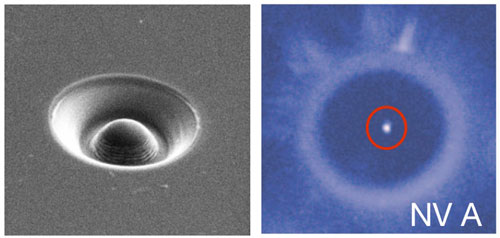| Feb 18, 2013 |
Catching quantum mechanics in the act
|
|
(Nanowerk News) Reporting in the Proceedings of the National Academy of Sciences ("Opening up three quantum boxes causes classically undetectable wavefunction collapse") this week, researchers from the Netherlands, Oxford and the London Centre for Nanotechnology at UCL have demonstrated a form of quantum superposition first predicted twenty years ago by the Israeli physicist Lev Vaidman.
|
|
Superposition is the ability of matter at the microscopic scale to exist in two apparently incompatible states at once; for instance, the needle of a quantum compass can point both north and south simultaneously.
|
|
The researchers used the magnetism of a single atom of nitrogen trapped in a high-purity diamond as their quantum mechanical compass. Under red laser light, the nitrogen atom fluoresced according to how it was magnetised.
|
 |
| An electron microscope image of a solid immersion lens cut into the surface of a high purity diamond crystal. At the focus of this lens, a single nitrogen atom trapped next to a missing carbon atom, circled in red, is shown fluorescing in the false colour image.
|
|
Superposition is a delicate effect and it is notoriously difficult to “catch matter in the act” of being superposed. The researchers found the direct approach of looking at the quantum magnet to determine which way it points did not work; instead the superposition was immediately destroyed and replaced with a state of pointing either north or south at random, hiding the evidence.
|
|
Rather than asking: “Is the magnet pointing north or south?” The researchers then asked: “Is it not pointing east?” Measurements that confirm “not east” are still compatible with the quantum superposition of pointing both north and south at the same time.
|
|
The researchers studied three successive rounds of measurement on the nitrogen quantum compass, and used correlations between different rounds to prove the presence of quantum superposition in their system. They adapted the work of Nobel Laureate Anthony Leggett to the nitrogen atom case.
|
|
Dr. Richard George of the London Centre for Nanotechnology, and first author on the paper, commented: “Our confirmation of these subtle quantum predictions is an important step on the road to transplanting quantum mechanics from a theoretical and laboratory curiosity and into the devices which we use in commerce and everyday life. Our vision is to scale up and build computers in which every ‘bit’ is replaced with a ‘quantum bit’ that uses superposition as an integral part of its operation”
|

